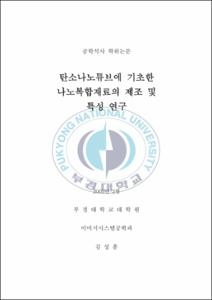탄소나노튜브에 기초한 나노복합재료의 제조 및 특성 연구
- Alternative Title
- Preparation and Characterization of Nanocomposites based on Carbon Nanotubes
- Abstract
- 본 논문에서는 화학적인 방법으로 탄소나노튜브의 표면에 작용기를 도입시키고, 도입된 작용기를 이용하여 다른 물질과 탄소나노튜브의 나노복합재료를 만드는 방법에 대하여 소개하였다. 나노복합재료의 제조에 쓰인 물질은 gold nanoparticles와 ZnS:Mn QDs를 사용하였다. 나노복합재료를 만드는 주된 방법은 amide linkage를 사용하였고, 탄소나노튜브의 표면에 도입시킨 carboxylic acid groups을 acylchloride groups으로 변환하여 반응을 진행하였다. acylchloride groups은 carboxylic acid groups 보다 높은 반응성을 가지기 때문에 amino groups과 반응하여 빠르게 amide linkage를 형성한다. 이 점을 이용하여 탄소나노튜브의 표면을 thiol 그룹으로 개질하여 gold nanoparticles과 SH groups 사이에 ligand exchange가 용이하게끔 만들었으며, ZnS:Mn QDs과 acylchloride groups로 변환된 탄소나노튜브의 합성반응 역시 진행하였다. 제조된 나노복합재료들은 각각의 특성에 따른 측정을 하였다. gold nanoparticles의 광흡수 특성을 이용하여 UV-Vis. spectrometer 측정을 하였고, ZnS:Mn QDs의 광발광 특성을 이용해 PL 측정을 하였다. 또한, TEM과 EDX 측정으로 각각의 나노복합재료의 morphology를 확인하였다.
본 논문에서는 나노복합재료를 제조함에 있어, 공유결합 방법을 이용한 제조법에 대해 기술하였다. 기존의 비공유결합을 이용한 방법이 탄소나노튜브와 소재와의 계면접착력이 부족하고, 탄소나노튜브의 응집성 때문에 균일한 분산이 어려웠던 부분이 있었는데, 분자 단위에서 탄소나노튜브와 나노물질의 나노복합소재를 합성함으로써 문제점들을 해결하였다. 공유결합방법은 비공유결합방법이 이용하는 van der waals 힘에 비해 10배 이상 단단한 힘으로 결합을 이루기 때문에 이상적인 제조방법이라고 할 수 있다. 하지만 산화과정에서 생기게 되는 defects는 탄소나노튜브의 전기전도도에 영향을 끼치기 때문에 이 부분에 대한 연구가 더 진행되어야 할 것이다.
이 논문에서는 amide linkage를 이용한 간단한 방법으로 나노복합재료를 만들었다. 이와 같은 방법으로 표면을 amino group으로 처리한 물질과 탄소나노튜브와의 나노복합재료를 제조법을 제시하였다.
Carbon nanotubes have been intensively investigated for potential applications due to their outstanding physical properties. In the meantime, noble metal nanoparticles and semiconducting nanocrystals, have become the focus of many researchers because of their unique properties.
Carbon nanotubes with Quantum Dots (QDs) or Gold nanoparticles (AuNPs) are being evaluated for a variety of optoelectronic applications and nanomaterials based solar cells and several other applications. Each material has shown a rich chemistry for functionalization, and ample number of studies for application have been evaluated based on the combination of these materials. The nanocomposites combining carbon nanotubes and nanoparticles might improve their performances and extend the applications.
In this study, ZnS QDs and AuNPs were synthesized using a literature protocol, and attached to carbon nanotubes by covalent method. The resulting nanocomposites were characterized by UV-Vis spectrometer, phosphorescence measurements, and X-ray diffractometer (XRD). High resolution TEM and Energy dispersive X-ray spectrometer (EDX) studies were performed to confirm the immobilization of nanopartices to carbon nanotubes.
- Issued Date
- 2009
- Awarded Date
- 2009. 2
- Type
- Dissertation
- Keyword
- 나노
- Publisher
- 부경대학교 대학원
- Alternative Author(s)
- Kim, Sung Hun
- Affiliation
- 부경대학교 대학원
- Department
- 대학원 이미지시스템공학과
- Advisor
- 정연태
- Table Of Contents
- Ⅰ. 서론 = 1
Ⅱ. 이론적 배경 = 3
1. 나노복합재료 = 3
2. 탄소나노튜브 = 3
가. 탄소나노튜브의 구조 = 5
나. 탄소나노튜브의 성질 = 10
Ⅲ. 실험방법 = 13
1. Materials and Chemicals = 13
가. 탄소나노튜브의 표면개질 = 13
나. Gold Nanoparticles = 14
다. ZnS:Mn Quantum Dots = 15
2. 탄소나노튜브의 표면개질 = 16
3. 나노복합체의 제조 = 18
가. MWNTs/AuNPs 나노복합체 = 18
나. MWNTs/ZnS:Mn QDs 나노복합체 = 19
4. 분석기기 = 20
가. MWNTs의 분석 = 20
나. MWNTs/AuNPs 나노복합체의 분석 = 20
다. MWNTs/ZnS:Mn QDs 나노복합체의 분석 = 21
Ⅳ. 결과 및 고찰 = 22
1. MWNTs의 표면개질 = 22
가. FT-IR 분석 = 22
나. TGA 분석 = 25
다. FE-SEM 분석 = 26
2. MWNTs/AuNPs 나노복합체 = 29
가. UV-Vis. spectrometer 분석 = 29
나. TEM / EDX 분석 = 32
3. MWNTs/ZnS:Mn QDs 나노복합체 = 36
가. PL / XRD 분석 = 36
나. TEM / EDX 분석 = 39
Ⅳ. 결론 = 43
Ⅴ. 참고문헌 = 45
- Degree
- Master
- Files in This Item:
-
-
Download
 탄소나노튜브에 기초한 나노복합재료의 제조 및 특성 연구.pdf
기타 데이터 / 2.71 MB / Adobe PDF
탄소나노튜브에 기초한 나노복합재료의 제조 및 특성 연구.pdf
기타 데이터 / 2.71 MB / Adobe PDF
-
Items in Repository are protected by copyright, with all rights reserved, unless otherwise indicated.